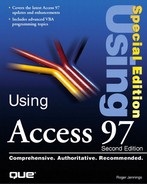Defining the Client/Server Environment
Client/server databases are designed specifically for use on application server-based networks. An application server uses a network operating system, such as Windows NT Server, that is optimized specifically for running applications rather than sharing files or peripheral devices. Client/server databases have many advantages over conventional database systems, including increased database security, the incorporation of all components of the database, in a single file, and faster access to networked data. The clients of a client/server database are workstations, often called front-ends, that are connected to the server, called the back-end. In these respects, the "split" Access databases, described in the preceding chapter, and client/server databases are similar. The principal difference between Access and a typical client/server database manager, such as Microsoft SQL Server, is that the client/server RDBMS performs many operations on the server that traditionally are carried out by database applications running on the client workstation.
Client/server database managers accept SQL statements from client applications. The client/server RDBMS interprets the SQL statement and executes the actions specified in the statement. If you send a SELECT query SQL statement to the server, the server returns only the result set to the client; processing of the query occurs on the server computer. This action speeds query generation two ways: The amount of information traveling over the network is reduced, and server computers often have much more powerful and faster microprocessors than the workstation clients.
Note
SQL Server isn't limited to traditional client/server architecture in which clients connect to the server via a network. You can use Access front-ends on the same Windows NT server that runs SQL Server. Microsoft also offers a developer's version of SQL Server that runs as a service on Windows NT Workstation. Microsoft announced in the fall of 1996 its intention to port SQL Server to Windows 95, making SQL Server a direct competitor to the Jet database engine.
To understand many of the examples in this chapter, you need to know how the computers that create the examples are set up. The following list describes the computers and network used to create this chapter's examples of employing ODBC for connecting to client/server databases:
The primary server (OAKLEAF0) is a 133-MHz Pentium clone with 64M of RAM and a 4.3G Seagate Barracuda Fast, Wide SCSI-2 fixed-disk drive that is connected to an Adaptec AHA-2940UW fixed-disk controller on the PCI bus. Windows NT Server 4.0 is installed as a Primary Domain Controller (PDC) on the 2G C: drive formatted with NTFS (Windows NT's New Technology File System). The 2.3G D: partition is used for file sharing. The E drive is a Toshiba double-speed SCSI CD-ROM drive. A 1G Tandberg tape backup drive also connects to the SCSI bus.
A second server (OAKLEAF3) is a 166-MHz Pentium PC with a PCI bus, 32M of RAM, and two 4.3G Seagate Barracuda Wide, Fast SCSI-2 drives that are connected to an Adaptec AHA-2940UW. \OAKLEAF3, which dual-boots Windows 95 and Windows NT Server 4.0 (as a Backup Domain Controller or BDC), is used primarily for digital video capture with an Interactive Images Plum card and non-linear digital video editing by using Adobe Premiere 4.2. OAKLEAF3 has a 4x SCSI-2 CD-ROM and a Hewlett-Packard ScanJet IIcx scanner that are connected to the narrow SCSI port of the AHA-2940UW.
Microsoft SQL Server 6.5 runs as a service under Windows NT Server 4.0 on the OAKLEAF0 and OAKLEAF3 servers. (A Windows NT service is an application that starts automatically when you boot Windows NT, before the user logs on.) Exchange Server 4.0, Internet Information Server 3.0, and Microsoft Media Server 1.0 also run as services on OAKLEAF0. SQL Enterprise manager, the administrative application for SQL Server 6.5, is installed on all computers except OAKLEAF2.
The client used to write this edition (OAKLEAF1) is a 133-MHz Pentium PCI-bus clone with 16M of RAM, and 300M, 600M, and 1.2G IDE fixed disks, plus a 2X SCSI CD-ROM drive connected to the SCSI port of a Sound Blaster 16 audio adapter. OAKLEAF1 dual-boots Windows NT Workstation 4.0 and Windows 95.
Another client (OAKLEAF2) is an 80486DX2-66 ISA clone with 8M of RAM and a 300M IDE disk drive that runs Windows 95. OAKLEAF2 is used primarily for composing and sequencing music. It is equipped with a variety of legacy (pre-Plug and Play) sound cards and several MIDI synthesizer modules. The 80486 client is used for testing the performance of custom applications (except Access 97 applications) on yesterday's average client workstation configuration. 16-bit MIDI sequencing applications run fine under Windows 95 on OAKLEAF2, but trying to run Access 97 applications on 80486DX-33 PCs with 8M of RAM definitely is not recommended.
All servers and clients are equipped with Intel EtherExpress 16 Pro network interface cards (NICs) that are connected via thin Ethernet coaxial cabling. The LAN uses both NetBEUI and TCP/IP protocols. OAKLEAF0 and OAKLEAF3 also have Intel 100BaseT Fast Ethernet adapters for transferring compressed digital video data at rates up to about 42 Mbps. Remote Access Services (RAS), which allow dial-up (modem and ISDN) connections to the OAKLEAF0 server, are also implemented. Figure 25.1 shows the configuration of the network used for the examples discussed in this chapter.
If the preceding description appears to be written in Greek, don't despair; knowing the computer setup is necessary only to explain the entries in the text boxes of the dialogs that are illustrated in this chapter. Network systems of the complexity of the above configuration are common where a variety of operating systems, sometimes in both retail and beta versions, are used.
Figure 25.1. The network topology of the computers used to write this book.

